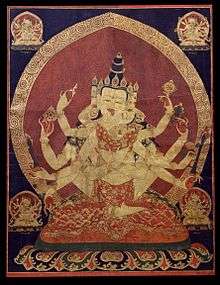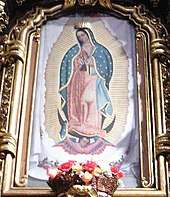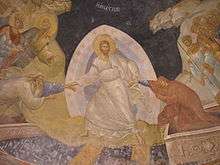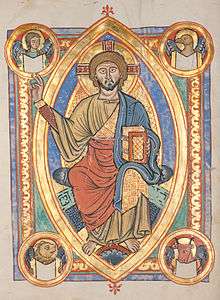Aureola
An aureola or aureole (diminutive of Latin aurea, "golden") is the radiance of luminous cloud which, in paintings of sacred personages, surrounds the whole figure.



In Romance languages, the noun Aureola is usually more related to the disc of light surrounding the head of sacred figures and that in English is called Halo or Nimbus.
In art
In the earliest periods of Christian art it was confined to the figures of the persons of the Christian Godhead, but it was afterwards extended to the Virgin Mary and to several of the saints.
The aureola, when enveloping the whole body, generally appears oval or elliptical in form, but occasionally depicted as circular, vesica piscis, or quatrefoil. When it appears merely as a luminous disk round the head, it is called specifically a halo or nimbus, while the combination of nimbus and aureole is called a glory. The strict distinction between nimbus and aureole is not commonly maintained, and the latter term is most frequently used to denote the radiance round the heads of saints, angels or Persons of the Trinity.
This is not to be confused with the specific motif in art of the Infant Jesus appearing to be a source of light in a Nativity scene. These depictions derive directly from the accounts given by Saint Bridget of Sweden of her visions, in which she describes seeing this.[1]
Development
The nimbus in Christian art first appeared in the 5th century, but practically the same motif was known from several centuries earlier, in pre-Christian Hellenistic art. It is found in some Persian representations of kings and gods, and appears on coins of the Kushan kings Kanishka, Huvishka and Vasudeva, as well as on most representations of the Buddha in Greco-Buddhist art from the 1st century AD. Its use has also been traced through the Egyptians to the ancient Greeks and Romans, representations of Trajan (arch of Constantine) and Antoninus Pius (reverse of a medal) being found with it. Roman emperors were sometimes depicted wearing a radiant crown, with pointed rays intended to represent the rays of the sun. According to Islamic tradition, the Prophet Mohammed may not be depicted representationally; however some religious artists have indicated his presence in historical scenes using an empty, flaming aureole as a placeholder.
In the circular form the nimbus constitutes a natural and even primitive use of the idea of a crown, modified by an equally simple idea of the emanation of light from the head of a superior being, or by the meteorological phenomenon of a halo. The probability is that all later associations with the symbol refer back to an early astrological origin (compare Mithras), the person so glorified being identified with the sun and represented in the sun's image; so the aureole is the Hvareno of Mazdaism.[2][3] From this early astrological use, the form of "glory" or "nimbus" has been adapted or inherited under new beliefs.
Mandorla

A mandorla is a vesica piscis shaped aureola which surrounds the figures of Christ and the Virgin Mary in traditional Christian art.[4] It is commonly used to frame the figure of Christ in Majesty in early medieval and Romanesque art, as well as Byzantine art of the same periods. The term refers to the almond like shape: "mandorla" means almond nut in Italian. In icons of the Eastern Orthodox Church, the mandorla is used to depict sacred moments which transcend time and space, such as the Resurrection, Transfiguration, and the Ascension. These mandorla will often be painted in several concentric patterns of color which grow darker as they come close to the center. This is in keeping with the church's use of Apophatic theology, as described by Dionysius the Areopagite and others. As holiness increases, there is no way to depict its brightness, except by darkness.
In a famous romanesque fresco of Christ in Glory at Sant Climent de Taüll, the inscription "Ego Sum Lux Mundi" ("I Am the Light of the World") is incorporated in the Mandorla design.[5]
The tympanum at Conques has Christ, with a gesture carved in romanesque sculpture, indicate the angels at his feet bearing candlesticks. Six surrounding stars, resembling blossoming flowers, indicate the known planets including the Moon. Here the symbolism implies Christ as the Sun.[6]
In one special case, at Cervon (Nièvre), Christ is seated surrounded by eight stars, resembling blossoming flowers. At Conques the flowers are six-petalled. At Cervon, where the almond motif is repeated in the rim of the mandorla, they are five-petalled, as are almond flowers -the first flowers to appear at the end of winter, even before the leaves of the almond tree. Here one is tempted to seek for reference in the symbolism of the nine branched Chanukkiyah candelabrum. In the 12th century a great school of Judaic thought radiated from Narbonne, coinciding with the origins of the Kabbalah.[7] Furthermore, at Cervon the eight star/flower only is six petalled: the Root of David, the Morningstar, mentioned at the close of Book of Revelation (22:16) [8] (In one of the oldest manuscripts of the complete Hebrew Bible, the Leningrad Codex, one finds the Star of David imbedded in an octagon.)
In the symbolism of Hildegarde von Bingen the mandorla refers to the Cosmos.[9]
Aureole (atmospheric phenomenon)
In meteorology, an aureole is the inner disk of a corona, an optical phenomenon produced by the diffraction of light from the Sun or the Moon (or, occasionally, other bright light sources)[10] by individual small water droplets and sometimes tiny ice crystals of a cloud or on a foggy glass surface.[11][12] The aureole is often (especially in case of the Moon) the only visible part of the corona and has the appearance of a bluish-white disk which fades to reddish-brown towards the edge.
See also
- Aura
- Aureole effect
- Crown of Immortality
- Five Crowns
- Glory
- Halo
- Heiligenschein
- Velificatio
References
- G Schiller, Iconography of Christian Art, Vol. I,1971 (English trans from German), Lund Humphries, London, pp. 76-78 & figs, ISBN 0-85331-270-2
- Ramsden, E. H. (April 1941). "The Halo: A Further Enquiry into Its Origin". The Burlington Magazine for Connoisseurs. The Burlington Magazine Publications, Ltd. 78 (45): , p. 131. JSTOR 868232.
- Encyclopædia Britannica, 14th Edition, Vol. 15. Encyclopædia Britannica, Inc. p. 620.
- Liungman, Carl G. (1991). Dictionary of Symbols. W.W. Norton. p. 287. ISBN 0-393-31236-4.
- Conjunt iconogràfic de Sant Climent de Taüll
- Image
- Scholem, Gershom (1990). Origins of the Kabbalah. Princeton Paperback. ISBN 0-691-07314-7.
- Image
- Riedel, Ingrid (1994). Hildegard von Bingen, Prophetin der kosmischen Weisheit. Kreuz Verlag, Zürich.
- Cowley, Les (2012). "Jupiter corona from Iran". Atmospheric Optics. Retrieved 2016-05-02.
- Calvert, J. B., The Corona, University of Denver, 2 August 2003. Access date 11 Feb. 2107
- Cowley, Les, Corona, Atmospheric Optics. Access date 11 Feb. 2107
Further reading
- Timmers J.J.M. A Handbook of Romanesque Art New York London 1969 Icon Editions, Harper and Row
- Gérard de Champéaux, Dom Sébastièn Sterckx o.s.b. Symboles, introduction à la nuit des temps 3, Paris 1966 ed. Zodiaque (printed: Cum Permissu Superiorum)
- Adolphe Napoléon Didron, Christian iconography or, the history of Christian art in the Middle Ages London 1886 https://archive.org/stream/christianiconogr01didruoft
- Brian Young The Villein's Bible; stories in romanesque carving London 1990 Barry & Jenkins
- Roger Cook The Tree of Life: Image for the Cosmos New York 1974 Avon Books
- Parry, Ken; David Melling (editors) (1999). The Blackwell Dictionary of Eastern Christianity. Malden, MA.: Blackwell Publishing. ISBN 0-631-23203-6.CS1 maint: extra text: authors list (link)
External links
